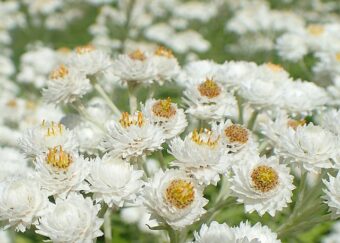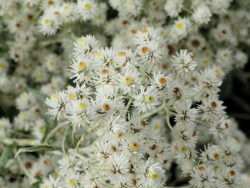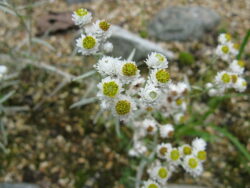In this article, we will discover how to grow the wonderful hardy perennial of Anaphalis in containers. It is a flowering plant that belongs to the Aster family where 110 species are known to exist and are mainly found in Central and Southern Asia. This is one species native to North America (Anaphalis margaritacea) which is also a popular cultivation that you can find. Its common name comes about because the flowers and stems when dried make great decorations throughout the winter months.

This is the main reason why pearl everlasting is grown as the flower stems are a flower arranger’s delight.
No matter what species are grown, they are noted for the clumps of silvery-grey leaves that are produced, which are topped by clusters of white flowers with yellow centres. It is noted for its rapidness of spreading where the plant can make a useful ground cover.
HOW TO GROW ANAPHALIS
You can grow Anaphalis from seed or garden-ready shop-bought plants. If you are planting seeds you will need to plant very early as they can take a long time to germinate.
GROWING FROM SEED
All you need to do is fill a seed tray at your home with moist seed sowing compost. On top of the compost, sprinkle finely the seeds and cover them with a thin layer of sieved compost. Cover with a propagator lid and place it in a cool area. It can take between 30 to 60 days for the seed to germinate.
Once the seedlings have reached a stage where it is big enough to handle, they can be pricked out individually to 7.5cm pots full of multipurpose compost, allow the plants to grow on and in late May, you can start to harden them off before planting in containers outside.

At this stage, you can treat home-reared plants and shop-bought, garden-ready plants in exactly the same way.
First, choose a container that is within proportions and will suit the plant in question. No matter what you choose make sure it has plenty of drainage holes. To this container, add a 1cm layer of gravel to aid drainage and on top of this add multipurpose compost to within 5cm of the top rim.
Dig a hole in the compost that is slightly bigger than the root ball at the original container that it came in. Place the plant in so that the top of the root ball is at the same level as the top surface of the compost in the container. Backfill it with the growing media so that no gaps remain, even using more compost if necessary. Water well and firm the plant in.
CARE INSTRUCTIONS
It is best to place the plant in full sun but it can tolerate light shade. It is fully hardy in the UK. You will need to water regularly until the plant is well established and after this, it will tolerate drought pretty well. You will need to water when 5cm below the top surface of the compost feel dry to the touch.
The plant will tolerate poor soil and will not need feeding unless the plant is showing clear signs of being undernourished. In spring, you can give a feed of a handful of fish, blood and bone to give enough food to get it through the growing season.
Tall varieties may need to be stalked to support them. This is one plant that does not need to be pruned. All you need to do is remove spent stems in spring, where they can provide interest overwinter. In spring, cut close to the base.
PESTS AND DISEASES
The good news is that this plant does not suffer from pests and diseases. This makes them easy to look after.
VARIETIES TO GROW
There are 4 species that can be grown in the UK.

A. triplinervis grows up to 45cm high and has narrow, green-grey leaves that are topped with stems having white flowers and yellow centres. A more compact and nectar-rich variety is ‘Summer Snow’
A. margaritacea is a larger plant and has silvery-grey leaves that are topped with stems of white flowers with yellow eyes.
A. margaritacea var. cinnamomea has pointed grey-green leaves and heads of papery white flowers with light yellow centres. A taller variety than A. margaritacea.
A. yedoensis a tall variety that has narrow green-grey leaves and large white flower heads with dark centres.
CONCLUSIONS
In this article, we have discussed how to grow the perennial Anaphalis in containers. They are plants that make good flowers dried from flower arrangers and more than that they are easy to look after, requiring less in the way of feeding and watering.
A plant that not only looks good but also brings much need white to the container display scheme. If you have any questions or comments that you would like to make on Anaphalis in containers, please do so in the comment box below.
Happy Anaphalis growing.
